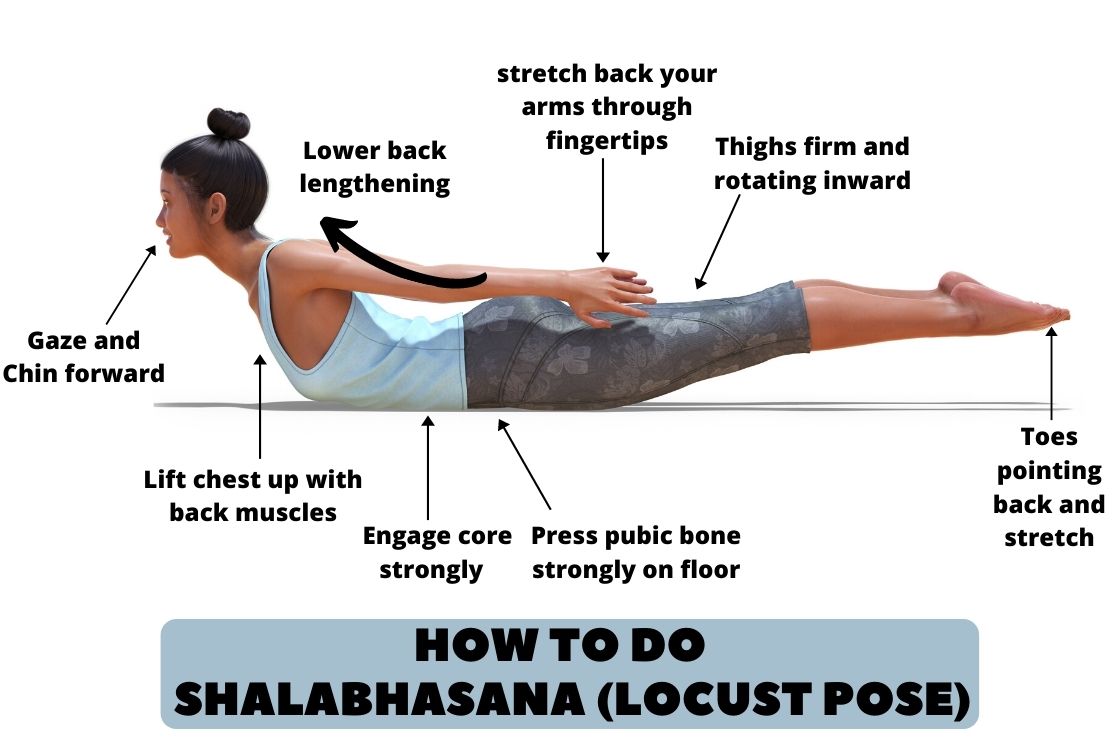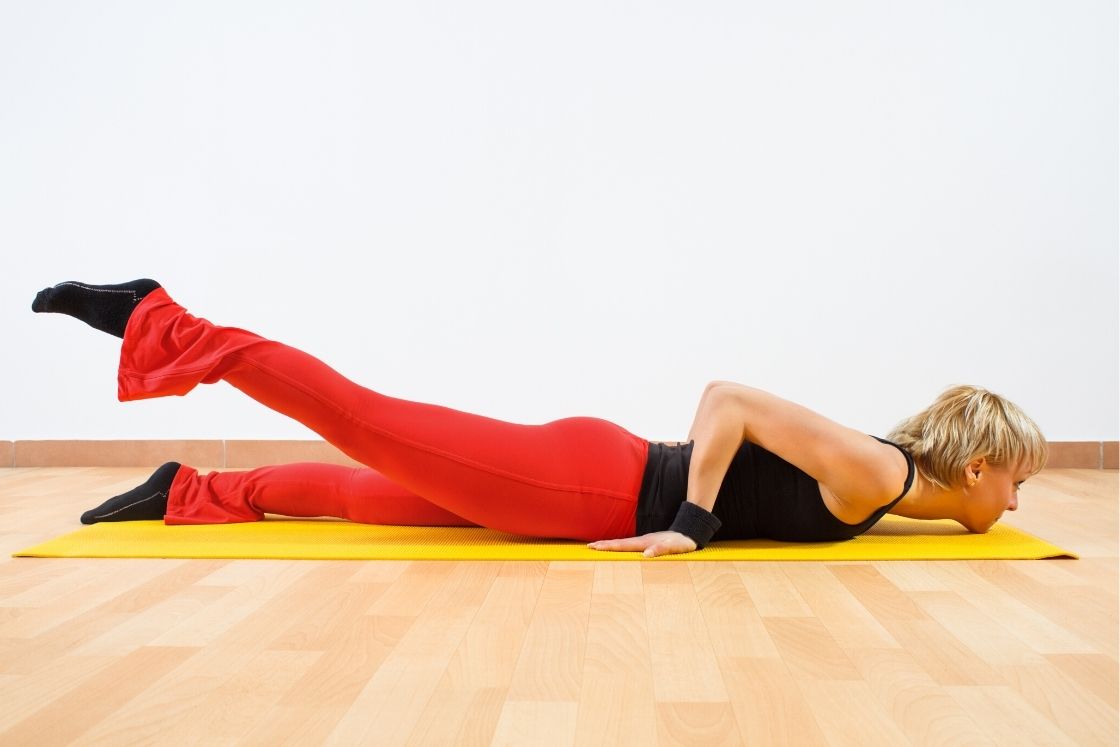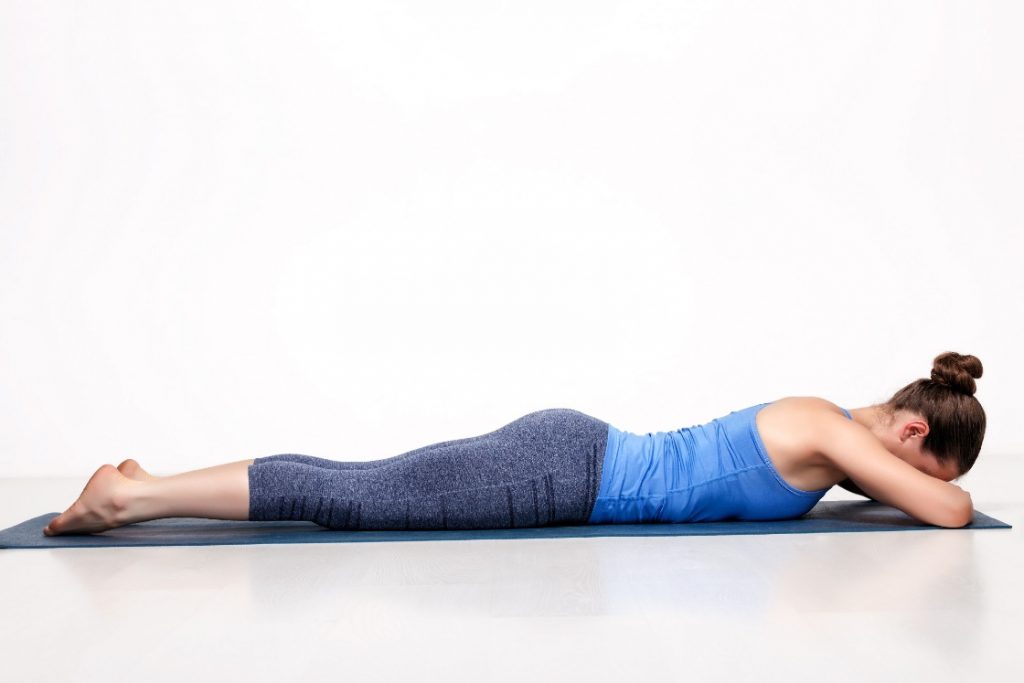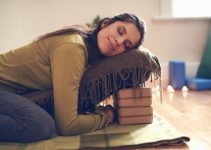
Shalabhasana is a prone back-bending yoga asana. It’s one of the “baby backbends” that help beginner yogis to deepen their back-bending practice. Physically, after practicing this asana you may find relief from back pain-causing muscle.
Back bend action of Shalabhasana is different from other backbends:
- Shalabhasana is the only backbend where we use back extensors to get into the posture and do not prevent this with the opposite action.
- In other backbends, to deepen the pose, we work against our arms and legs. But here we do the same against the gravity.
The primary purpose of practicing shalabhasana is to awaken and reinforce the back extensors muscles along with flexibility.
Meaning
In Shalabhasana, ‘shalabh‘ means ‘locust’ or ‘grasshopper’ and ‘asana‘ means ‘pose’. The body in the extended torso and stretched hands make this pose looks like to locust resting on the field, so the name is locust pose.
The spine gets a smooth stretch in this asana. But to stretch out and lift legs and hands simultaneously, one needs to have good strength in the upper and middle back.
This asana is described under the “Complete illustrated book of the yoga” of Shivanada’s tradition by swami Vishnudevananda in 1960.
Practice Guide of Shalabhasana

Go through the following points below for safe and easy practice of Shalabhasana.
Precautions and Contraindications
- Pregnant and Menstruating women should refrain from practicing shalabhasana.
- People with spine injury avoid this asana. Practitioners with lower back pain can do mild practice after pain vanishes and injury to the concerning region should avoid.
- High blood pressure patients should avoid breath retaining and holding Shalabhasana for long.
- People with a hernia, potbelly, and those who have undergone surgery in the past few months are not advisable to practice shalabhasana.
Preparatory Pose
Shalabhasana Steps
- Begin by lying prone on your mat. Your forehead resting on the floor, palms along the side of the torso touching the floor.
- Now, with exhalation lift off your head, chest, and leg simultaneously from the floor. Stretch your limbs as much as possible by raising them.
- Remember, do not rest your ribs on the floor. Only the front abdomen and front pelvis remain on the floor or bears the weight.
- Contract your buttocks while stretching your thigh muscles. Touch at the knees, thighs, and ankles, and your both leg fully extended.
- Fix your gaze forward or slightly upward and chin should remain parallel to the floor. Check if the back of your neck is under compression.
- This completes the Shalabhasana, called Purna Shalabhasana. Your stretched and elevated legs and torso will be in concave shape at the final step.
Release
Maintain the posture as long as breathing is normal. In the beginning, there would be difficulty in holding the posture but as the core becomes stronger one can see the change in holding time period.
Normally, stay in the pose for 30 seconds to 1 minute, then release it with exhalation. Slowly lower your limbs, in the same manner, they went into the pose, then the torso, pelvis, and finally the head.
Beginners Tips
- Beginners might face problems in raising both legs in the air. So, an alternate to this is, one can lift their leg one by one (left and right) for a specific period of time.
- The detachment of the chest is another challenge for the beginner to cope with. For this, one can place hands slightly behind the shoulder or along the waist and then apply pressure to get uplifted.
Props and Modifications
- There would be chances of getting injured while balancing the body over the chin. Using a blanket under the chin or replacing the chin forehead could be the remedy.
- In case of experiencing pressure under the chest, one can put a folded blanket. This will assist in maintaining the posture without affecting breathing.
- Beginners can place their hands underneath their thighs to help themselves in lifting the former. However, avoid weight on the wrist as it could cause an injury.
Follow up Pose
- Boat Pose (Naukasana)
- Bridge Pose (Sethu Bandha Sarvangasana)
- Bow Pose (Dhanurasana)
Variations
Following asanas can be used as a varitaion of Shalabhasana.
1. Ardha Shalabhasana

Ardha shalabhasana is an effective approach before you leap on to the Purna Shalabhasana.
In this, practitioners can raise one leg and the opposite arm at one time. For example, raise the left leg and right arm with other corresponding limbs off the floor. Afterward, the Right leg and left arm should be raised while the other two limbs on the floor.
2. Makarasana

Makarasana is the crocodile pose that can be practiced as a variation of Shalabhasana.
From lying prone in Shalabhasana, one can lift head to keep the palms underneath your jaws while elbows on the floor. Legs spread away from each other and toes pointing in the outward direction. Let your body feel grounded.
Shalabhasana Benefits
- Practicing this asana increases the strength, power, and endurance of back extensor muscles, lower back, erector spine, and upper back. According to one study, regular practice results in back extension in females.
- Shalabhasana provides relief in the case of gastric problems like flatulence, indigestion, etc. By applying pressure on digestive organs, it restores and enhances their functioning.
- Stretching involves in this asana improves the flexibility of the spine that eradicates the sacral and lumbar region’s pain. According to research, Shalabhasana practice along with other yoga interventions have a significant influence on serum BDNF (Brain-derived neurotrophic factor) and serotonin levels. These neuromodulators in the nociceptive pathway may mediate the beneficial effect of yoga on chronic low back pain.
- Pressure applied on the abdomen in Shalabhasana benefitted various internal organs including Prostate, Bladder, and uterus (female).
- Raising legs in this asana draws blood towards the pelvic region, which enhances reproductive cell nourishment. Therefore, regular practice restores sexual potency and improves sexual stamina as well.
- After holding for some time in Shalabhasana followed muscles actively involves throughout the process. As a result, returning muscles relax. This soothes and induces a feeling of tranquility that eradicates stress and anxiety.
- The horizontal position of the body allows optimum circulation in comparison to vertical where gravity applies resistance. Therefore, Practicing this asana ensures better blood circulation throughout the body.




